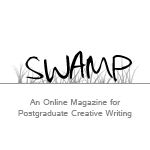Budgies in the Luggage and Parakeets on the Ceiling
Tessalia Simúr (University of Melbourne, Australia)
.
.
I. Birds that are called budgies in the southern country.
.
Of the many children my mother held in her belly, I was the only one to survive nine months of encasement. My conception was the last attempt in a series of melancholic failures: an ultimate, desperate measure that turned out wrong, like a crime. Mother never forgave me for surviving. All my siblings had died before me, and after I was born father was killed, so my existence became shadowed by the dead; a constant reminder of my lacking a right to remain here.
To find solace from the tragedy of my existence, Mother bred budgies, budgerigar, Melopsittacus undulatus; otherwise known—outside Ozstraliar, I would later learn—as Australian parakeets. She bought her first couple off a travelling menagerie on my fifth birthday. I got no present. And eventually, when she’d run out of excuses for ignoring me, she used the budgies. I can’t be bothered, I must feed the chicks, and with that she would leave me in the middle of the sandy ground, crying. That was the way it would always be.
Mother kept thirteen shabby cages in the garden corridor, filled to the brim with chaotically mating couples. The mere notion of caged birds in the middle of the country always seemed stupid to me. Rainbow lorikeets would sit on the neighboring tree, and boasted their freedom at the budgies. These would respond with melancholy shrills, knowing they had far less happiness in store than their colorful enemies. Out of pity, once in a while, I would let one of the chicks free. I knew it would die anyways, but at least the act demonstrated that some of the damned can be saved. I got away with this because it was my job to change the birdshit-covered-paper lying on sliding trays under the cages. Otherwise, Mother kept strict vigilance over her precious budgies. They were like the dead, untouchably sacred.
Christmas came and Mother announced we would be moving to the city. Not just to the city, but to a city across water. Of course the budgies were coming with us. With utmost care, we packed them all into a single cage and left the rest to rust along with the house. We could not carry thirteen cages and our luggage on the long boat ride. We sacrificed my clothes. We packed the birds and enough feed for three months. The trip was long, long enough for the budgies to do their thing. By the time we docked at the edge of the new city on the other side of the world, chicks were now parents, parents were grandparents, grandparents were great-grandparent, and great-grandparents were dead.
.
*
.
II. Birds that are called parakeets in the northern city.
.
During the first week in the city Mother walked into one of the many second-hand bookstores in town and bought herself Australian Parakeets and Their Mutations by Herman Kremer. No money for my schoolbooks that year, but the small balcony of our dingy apartment was fitted with two dozen shining new cages from the local pet shop. They are parakeets, not budgies, she now corrected. Thanks to the Kremer book Mother now thrived, mixing and matching her birds: the blue one mating with the green one, yielding two blues and one pink. She experimented endlessly: mixing orange and lime to get baby blue. The albino with the orange, giving her red. Since moving to the city her love towards the parakeets was more scientific, as if she thought that by controlling their mating she was civilizing them alongside ourselves. As her technique evolved, she created her favourite: a rare lavender parakeet she named Benja, who like everyone else in her life, broke her heart by dying.
She had woken up to find the bird twitching in its cage and held him, feeling the tiny body harden within seconds in her hands. She stood paralysed, realizing how different this body was to the soft breathing thing, but however dead, it still looked like a jewel. Then she knew what she must do. The lavender parakeet lay inside a shoebox for several days until Mother perfected her idea, but a week later the bird—having been carefully gutted and stuffed with cotton—dangled from the ceiling of the kitchen attached to a string.
Like a puppet in frozen flight. It became everything I could never be: true beauty. The first parakeet was joined by others, and together they would eventually fill the entire sky of our house. Their floating perfection seemed like the greatest evidence of my own imperfection. Mother no longer denied me by ignoring me, she now hurt me by loving them. She could never comb my hair with the love she showed when hanging dead parakeets from the ceiling. I could never compete with their immanence, so the day I glimpsed the possibility of revenge, I couldn’t avoid the pleasure.
A bird died in the night, a green parakeet that didn’t live to its second year, and a cat had tried to pry it out of the cage. The carcass was hardened and deformed, jammed between the wire mesh of the cage. Mother was not awake yet, and the mess of feathers would convince her that the cat had stolen the rest. I pulled the bird from its prison and stuck it into my skirt pocket instead of getting on the school bus, then walked to the entrance of the basement closet and hid inside, the frame of the anonymous door protecting me from the world.
I stared at the bird for a long time, lying on the cool tile floor. Its feathers full of colour and half its head gone. The single eye looked at me as if still alive, and an enormous pleasure derived from knowing that this lonely eye would rot. I had stolen my mother’s ideal of beauty, and now I was free to ruin it as I pleased: take it apart one leg at a time, set it on fire, and never allow it to be preserved. The maggots would be my allies and the worms my accomplices.
The parakeet lay in the bottom shelf of the closet for over a month, nobody ever came there except me. I visited it daily, relishing in its evolution: the bloating and inflammation, the ants walking in and out of orifices, the feathers becoming dust and the maggots writhing. I would never touch it, for I feared to disturb it.
Watching it was a beautiful thing. Until then I had lived in a world of permanence, where death only existed to prove my own imperfection, and observing its material effects was… illuminating. Over the months it took for the green parakeet to disappear, even the bones, I came to believe Mother was impossible to understand. I couldn’t know then that a conceptual difference concerning beauty was what separated us. She desired to keep things as they were, static and permanent. What I loved was dereliction inherent to change, the aesthetics of ruin we are all destined to become. The parakeet revealed the beauty of destruction, and I felt an impulse to protect it in some way, to record this history of obliteration that I was witnessing. But I still didn’t know how. I could only think of our house in the country across the ocean, and how it must now be overgrown by the bush, rotting and creaking under the rain, rusting in the sun; and I longed to be there again.
.
.
Tessalia Simúr. Was born in the midst of chaos and is forever shifting alongside borders of language, lands and disciplines; she is originally from Mexico City and now lives and studies creative writing, publishing and editing in Melbourne, Australia. Like most nomads she is constantly on the move.
The production of this work was supported by grants from Fondo Nacional para la Cultura y las Artes via Programa de Becas para Estudios en el Extranjero, Consejo Nacional de Ciencia y Tecnologia, and Secretaría de Educacion Pública.






